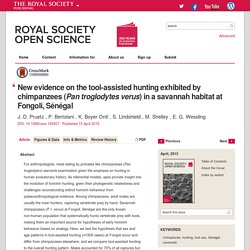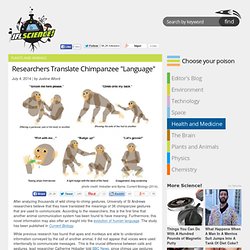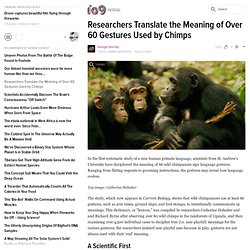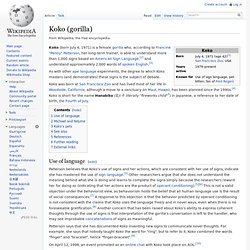

Untitled. Wild Chimps Look Out For Traffic Before Crossing Busy Road. New evidence on the tool-assisted hunting exhibited by chimpanzees (Pan troglodytes verus) in a savannah habitat at Fongoli, Sénégal. Abstract For anthropologists, meat eating by primates like chimpanzees (Pan troglodytes) warrants examination given the emphasis on hunting in human evolutionary history.

As referential models, apes provide insight into the evolution of hominin hunting, given their phylogenetic relatedness and challenges reconstructing extinct hominin behaviour from palaeoanthropological evidence. Among chimpanzees, adult males are usually the main hunters, capturing vertebrate prey by hand. Savannah chimpanzees (P. t. verus) at Fongoli, Sénégal are the only known non-human population that systematically hunts vertebrate prey with tools, making them an important source for hypotheses of early hominin behaviour based on analogy.
Here, we test the hypothesis that sex and age patterns in tool-assisted hunting (n=308 cases) at Fongoli occur and differ from chimpanzees elsewhere, and we compare tool-assisted hunting to the overall hunting pattern. 2. Figure 1. 3. 3.3 Statistical analyses 4. Figure 2. Table 1. Primate Intelligence. Researchers Translate Chimpanzee "Language" While previous research has found that apes and monkeys are able to understand information conveyed by the call of another animal, it did not appear that voices were used intentionally to communicate messages.

This is the crucial difference between calls and gestures, lead researcher Catherine Hobaiter told BBC News, since chimps use gestures as a communication system to convey messages to others. “That’s what’s so amazing about chimp gestures,” said Hobaiter. “They’re the only thing that looks like human language in that respect.”
In order to conduct this study, Hobaiter spent 18 months observing a group of wild chimpanzees in the Budongo rainforest in Uganda. She and colleague Richard Byrne then analyzed more than 4,500 chimp exchanges in order to decipher what the gestures could mean. They found that chimpanzees use 66 gestures to deliberately communicate 19 meanings. “What we’ve shown is a very rich system of many different meanings,” Byrne told Wired. Researchers Translate the Meaning of Over 60 Gestures Used by Chimps. What's with the article title?

It should read "Researchers Discover the Meaning of Over 60 Gestures Used By Wild Chimps. " I thought that researchers had discovered some sort of spoken language that wild chimps use when I first read the title. Word does not imply "spoken. " The gestures are like signs in sign language — they can be understood as "words" in the same way a sign can be understood as a word. Baboons kidnap and raise feral dogs as pets. Methodological-conceptual problems in the study of chimpanzees’ folk physics: How studies with adult humans can help. Chimps Are Better at Strategic Reasoning Than Humans Are. Washoe (chimpanzee)
Washoe Washoe (c.

September 1965 – October 30, 2007) was a female common chimpanzee who was the first non-human to learn to communicate using American Sign Language—to a limited degree—as part of a research experiment on animal language acquisition.[1] Washoe was born in West Africa in 1965. She was captured for use by the US Air Force for research for the space program.[6] Washoe was named for Washoe County, Nevada, where she was raised and taught to use ASL.[7] When Washoe was five, the Gardners decided to move on to other projects, and she was moved to the University of Oklahoma's Institute of Primate Studies in Norman, Oklahoma, under the care of the Foutses.[12] Washoe was raised in an environment as close as possible to that of a human child, in an attempt to satisfy her psychological need for companionship.[13][14][15] Washoe learned approximately 350 words of ASL.[2] These signs were then further tested using a double-blind vocabulary test.
Koko (gorilla) Koko (born July 4, 1971) is a female gorilla who, according to Francine "Penny" Patterson, her long-term trainer, is able to understand more than 1,000 signs based on American Sign Language,[2] and understand approximately 2,000 words of spoken English.[3] As with other ape language experiments, the degree to which Koko masters (and demonstrates) these signs is the subject of debate.

Patterson says that she has documented Koko inventing new signs to communicate novel thoughts. For The First Time, Chimpanzees Are Making A Fashion Statement. It’s a trend that’s taken a troop of chimpanzees by storm: a blade of grass dangling from an ear.

The "grass-in-ear behavior," as scientists have termed it, seems to be one of the first times that chimpanzees have created a tradition with no discernible purpose -- a primate fashion statement, in other words. There’s no doubt that chimpanzees have culture, as different chimp groups will use unique tools: to groom, to crack open nuts, to fish for termites. [YouTube] But, according to a study in the journal Animal Cognition, chimpanzee culture now includes something that seems altogether arbitrary: ear accoutrements. “Our observation is quite unique in the sense that nothing seems to be communicated by it,” says study author Edwin van Leeuwen, a primate expert at the Max Planck Institute in The Netherlands.
Lydia Luncz, a primatologist at the Max Planck Institute in Leipzig, Germany, who was not involved with the research, agrees. [Images courtesy of van Leeuwen, et al.]